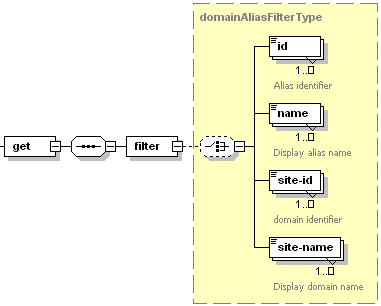Available Filters
This section describes some peculiarities of site alias filtering.
Filtering is the way the request XML packet indicates the object (one or several site aliases) to which the operation will be applied. The request XML filters site aliases using a special filter section. When created, a site alias is given a unique identifier and a unique name. Thus, to specify a site alias (e.g. for the set or get operation), the packet needs a special filter section structured as follows:

The DomainAliasFilterType (domainalias_input.xsd) allows you to
specify a site alias either by id, name, primary site id, or primary
site name. In addition, it allows you to specify multiple site aliases
within one filter. Finally, the filter can be left empty, which means
that all site aliases are selected.
- The id node is optional. It specifies the site alias by id. Data type: integer.
- The name node is optional. It specifies the site alias by name. Data type: string (Unicode).
- The site-id node is optional. It specifies the site alias by id of the primary site. Data type: integer.
- The site-name is optional. It specifies the site alias by name of the primary site. Data type: string (Unicode).
Note: Use <filter/> to update settings of all site aliases on the server or delete all site aliases from the server.
For example, a packet that retrieves the information about all site aliases looks as follows:
<packet>
<site-alias>
<get>
<filter/>
</get>
</site-alias>
</packet>